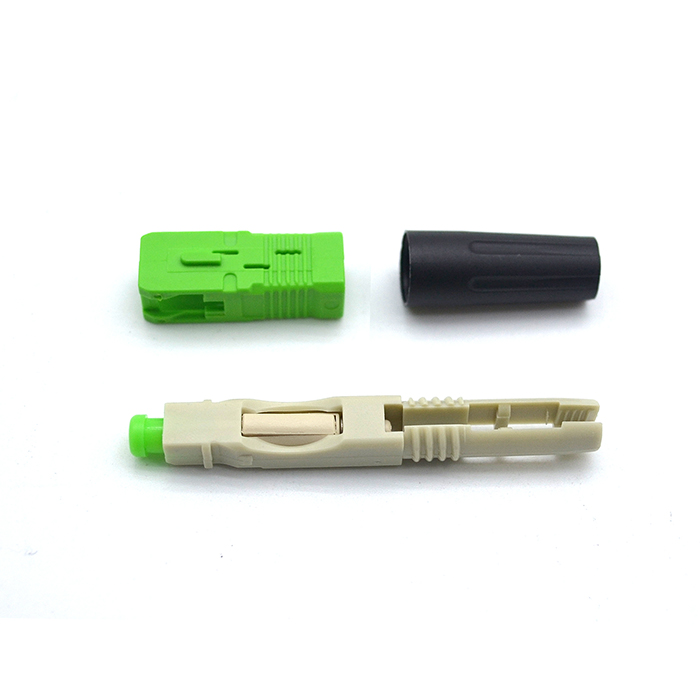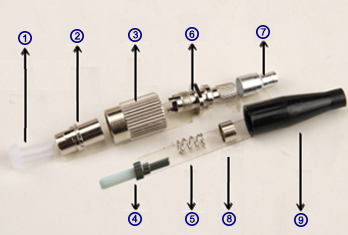

Single-mode fiber, LC connector, Bi-Directional, with blue and yellow color coding.
 EZX – 1550 nm, for distances up to 160 km (depending on fiber path loss). ZX – 1550 nm, for distances up to 80 km, (depending on fiber path loss). Single-mode fiber, LC connector, with green color coding. EX – 1310 nm, for distances up to 40 km. LX – 1310 nm, for distances up to 10 km. Single-mode fiber, LC connector, with blue color coding. LFX (name dependent on manufacturer) – 1310 nm, for a distance up to 5 km. FX – 1300 nm, for a distance up to 5 km. Multi-mode fiber, LC connector, with blue color coding. Multi-mode fiber, LC connector, with black or Beige color coding. The same applies to the QSFP-DD form factor with 8 lanes which can work downgraded to 4/2/1 lanes. Using a simple adapter or a special direct attached cable it is possible to connect those interfaces together using just one lane instead of four provided by the QSFP/QSFP+/QSFP28/QSFP56 form factor. Note that the QSFP/QSFP+/QSFP28/QSFP56 are designed to be electrically backward compatible with SFP/SFP+/SFP28 or SFP56 respectively. Specification published not yet in use as of August 2022 SFP modules are commonly available in several different categories. Transceivers are also designated by their transmission speed. twisted pair or twinaxial copper cables, multi-mode or single-mode fiber cables). SFP transceivers are available with a variety of transmitter and receiver specifications, allowing users to select the appropriate transceiver for each link to provide the required optical or electrical reach over the available media type (e.g. Its proponents say a low-cost adapter will allow for backwards compatibility with QSFP modules. The OSFP standard was initially announced in 2016 with the 4.0 version released in 2021 allowing for 800 Gbit/s via 8×100 Gbit/s electrical data lanes. It is a slightly larger version than the QSFP form factor allowing for larger power outputs. Īn alternative competing solution, the OSFP (Octal Small Format Pluggable) has products being released in 2022 capable of 800 Gbit/s links between network equipment. These use a form factor which is directly backward compatible to their respective predecessors. There are inexpensive adapters allowing SFP transceivers to be placed in a QSFP port.īoth a SFP-DD, which allows for 100 Gbit/s over two lanes, as well as a QSFP-DD specifications, which allows for 400 Gbit/s over eight lanes, have been published. In 2019, the closely related QSFP56 was standardized doubling the top speeds to 200 Gbit/s with products already selling from major vendors. In 2014, the QSFP28 variant was published allowing speeds up to 100 Gbit/s. The additional lanes allow for speeds 4 times their corresponding SFP. Ī slightly larger sibling is the four-lane Quad Small Form-factor Pluggable ( QSFP). In 2006, SFP+ specification brought speeds up to 10 Gbit/s and the SFP28 iteration is designed for speeds of 25 Gbit/s. At introduction, typical speeds were 1 Gbit/s for Ethernet SFPs and up to 4 Gbit/s for Fibre Channel SFP modules. SFP transceivers exist supporting synchronous optical networking (SONET), Gigabit Ethernet, Fibre Channel, PON, and other communications standards. The SFP replaced the larger gigabit interface converter (GBIC) in most applications, and has been referred to as a Mini-GBIC by some vendors. The form factor and electrical interface are specified by a multi-source agreement (MSA) under the auspices of the Small Form Factor Committee. modular connectors in Ethernet switches) is that individual ports can be equipped with different types of transceivers as required. The advantage of using SFPs compared to fixed interfaces (e.g. An SFP interface on networking hardware is a modular slot for a media-specific transceiver, such as for a fiber-optic cable or a copper cable. Small Form-factor Pluggable ( SFP) is a compact, hot-pluggable network interface module format used for both telecommunication and data communications applications.
EZX – 1550 nm, for distances up to 160 km (depending on fiber path loss). ZX – 1550 nm, for distances up to 80 km, (depending on fiber path loss). Single-mode fiber, LC connector, with green color coding. EX – 1310 nm, for distances up to 40 km. LX – 1310 nm, for distances up to 10 km. Single-mode fiber, LC connector, with blue color coding. LFX (name dependent on manufacturer) – 1310 nm, for a distance up to 5 km. FX – 1300 nm, for a distance up to 5 km. Multi-mode fiber, LC connector, with blue color coding. Multi-mode fiber, LC connector, with black or Beige color coding. The same applies to the QSFP-DD form factor with 8 lanes which can work downgraded to 4/2/1 lanes. Using a simple adapter or a special direct attached cable it is possible to connect those interfaces together using just one lane instead of four provided by the QSFP/QSFP+/QSFP28/QSFP56 form factor. Note that the QSFP/QSFP+/QSFP28/QSFP56 are designed to be electrically backward compatible with SFP/SFP+/SFP28 or SFP56 respectively. Specification published not yet in use as of August 2022 SFP modules are commonly available in several different categories. Transceivers are also designated by their transmission speed. twisted pair or twinaxial copper cables, multi-mode or single-mode fiber cables). SFP transceivers are available with a variety of transmitter and receiver specifications, allowing users to select the appropriate transceiver for each link to provide the required optical or electrical reach over the available media type (e.g. Its proponents say a low-cost adapter will allow for backwards compatibility with QSFP modules. The OSFP standard was initially announced in 2016 with the 4.0 version released in 2021 allowing for 800 Gbit/s via 8×100 Gbit/s electrical data lanes. It is a slightly larger version than the QSFP form factor allowing for larger power outputs. Īn alternative competing solution, the OSFP (Octal Small Format Pluggable) has products being released in 2022 capable of 800 Gbit/s links between network equipment. These use a form factor which is directly backward compatible to their respective predecessors. There are inexpensive adapters allowing SFP transceivers to be placed in a QSFP port.īoth a SFP-DD, which allows for 100 Gbit/s over two lanes, as well as a QSFP-DD specifications, which allows for 400 Gbit/s over eight lanes, have been published. In 2019, the closely related QSFP56 was standardized doubling the top speeds to 200 Gbit/s with products already selling from major vendors. In 2014, the QSFP28 variant was published allowing speeds up to 100 Gbit/s. The additional lanes allow for speeds 4 times their corresponding SFP. Ī slightly larger sibling is the four-lane Quad Small Form-factor Pluggable ( QSFP). In 2006, SFP+ specification brought speeds up to 10 Gbit/s and the SFP28 iteration is designed for speeds of 25 Gbit/s. At introduction, typical speeds were 1 Gbit/s for Ethernet SFPs and up to 4 Gbit/s for Fibre Channel SFP modules. SFP transceivers exist supporting synchronous optical networking (SONET), Gigabit Ethernet, Fibre Channel, PON, and other communications standards. The SFP replaced the larger gigabit interface converter (GBIC) in most applications, and has been referred to as a Mini-GBIC by some vendors. The form factor and electrical interface are specified by a multi-source agreement (MSA) under the auspices of the Small Form Factor Committee. modular connectors in Ethernet switches) is that individual ports can be equipped with different types of transceivers as required. The advantage of using SFPs compared to fixed interfaces (e.g. An SFP interface on networking hardware is a modular slot for a media-specific transceiver, such as for a fiber-optic cable or a copper cable. Small Form-factor Pluggable ( SFP) is a compact, hot-pluggable network interface module format used for both telecommunication and data communications applications. 

Small Form-factor Pluggable connected to a pair of fiber-optic cables For the multi-sport club based in Piraeus, Greece, see Olympiacos CFP.












